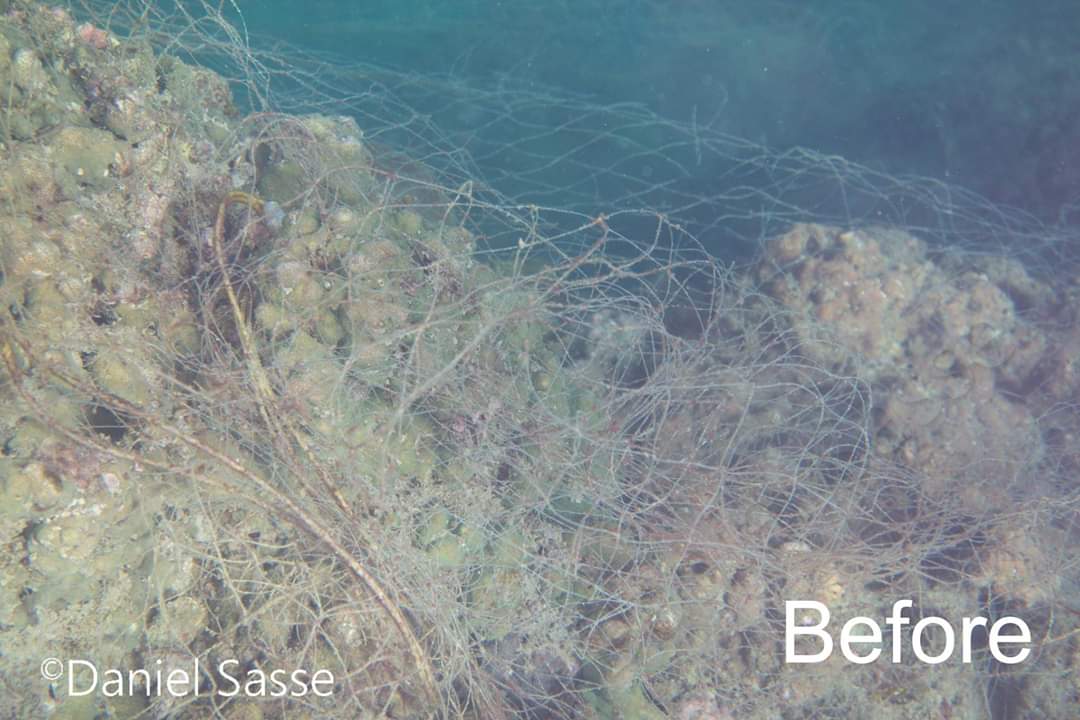Why is it so important to remove abandoned fishing nets from the reef or the seafloor?
First of all we have to understand why these fishing nets getting abandoned in the first place and mostly on reefs!?
Fish resources are usually much higher on reefs than they are in Open Water that’s due to fish find more places to hide and more food availability.
We can realize abandoned fishing net removals through the sale of our Underwater NFT images. Such as the one Serap and Sunny bought.

Fishers moving too close to the reef!
So the Fishing fleet goes as close to a reef as they can, to get their nets filled to the maximum.
Unfortunately or better fortunately on a reef there are not only Fish but also Corals and often these are branching Corals such as the one on this Picture
Fishing nets can easily get entangled into branching Corals by just running over them.
Some of the Corals break off with strong force but if it is entangled into more than one Coral it might get stuck.

But first we want to know what is a Coral and how it works?
A Coral is NOT a plant as many think, it is an animal.
On the left you can see a diagram of the anatomy of a Coral Polyp and a colony
A coral polyp is essentially a round animal with a mouth in the center and a ring of tentacles around the mouth. The flat disc separating the tentacles from the mouth is called the “oral disc”. The tentacles possess stinging cells (called nematocysts) and can be used to sting, paralyze, and capture prey. If the animal is disturbed or not eating, it may close and retract its tentacles, but the circular outline of the polyp and its mouth is still visible, though a magnifying glass is a good idea because even the larger ones are only a few millimeters in width.
So a Coral Colony exists of many single Coral polyps as you can see on the left
The individual coral animal is called the polyp. This simple sac-like animal secretes and lives in a skeleton cup made of calcium carbonate, called a corallite. Together the tissue and the skeleton of a coral is called the corallum. The corallum that grow in groups is called the coral colony. Singular corallum is simply called solitary coral.

As you can see on the left this is an abandoned Fishing Net entangled into a branching Coral.
Now to extend the previous paragraph, the Coral in this state is limited in food sourcing, growing and stressed due to the entanglement
On the lower Coral you can already see that the Coral is turning whiteish which corals do when they are stressed and/or can’t feed properly as well as high water temperatures over 32.2°C over a longer period.
Once a Fishing net is entangled into a Coral the Fisher can’t pull it up anymore the net will be cut off on the surface and abandoned.
The reason for that is that unfortunately a new one is cheaper to buy than to remove or fix the one stuck in the corals.
So when we as scuba divers go diving we often come across these kind of abandoned fishing nets and obviously we’ll remove them. Depending on the size sometimes with customers and sometimes we have to come back without our customers as it is to hazardous or to big of a job.

Abandoned fishing nets kill for a long time!
Abandoned Fishing nets are a problem for the reef for a very long period of time as they kill fish and corals as long as they are left on the reef due to post entanglement.
Fishing Nets are not biodegradable as they are mostly made of nylon twine. They probably will get overgrown at some point in the next 30-50 years but that’s not sure.

Overfishing and illegal fishing:
In the last 60 years, around 90% of the stocks of large predatory fish have already disappeared worldwide.
We are losing species as well as entire ecosystems, putting the ecological integrity of our oceans under stress and risking mass extinctions.
This means that, collectively, almost 80% of the world’s fish stocks are fully or overexploited, depleted or in a state of collapse.
Humans have gotten way too strong with all the machines and fishing fleets we use to catch fish. The total number of fishing vessels worldwide in 2016 was estimated at about 4.6 million.
It is estimated that 1-2.7 trillion wild fish are caught worldwide each year. This estimates to a 90 million metric tons of fish caught per year. Unrecorded fish catch, such as illegally caught fish or fish caught as by-catch which will be discarded over board (by-catch is often 40% of a full net that cannot be used and is discarded again), is not included in this estimate.
Did you know that there are still government subsidies for fishing boats?

It takes a long time to remove abandoned fishing nets
Du to the complexity of the way a coral grows it is often hard to remove abandoned fishing nets.
We use scissors instead of knives as you can get easier under the tight twine and can cut it. With a knife you more likely destroy due to ripping compared to cutting.
Due to current waves and surge the twine of an abandoned fishing net wraps around a coral tighter and tighter.
Obviously we don’t want to damage the coral any more than it already has been.
Often not easy think about current, waves, buoyancy control of the diver at the same time having a sharp utensil in your hand and don’t want to destroy any of your scuba regulator hoses or anymore of the coral…
Also some parts of the net which are cut off of the coral will float back into the next branch of coral and get stuck again if not taken care off. That’s why abandoned fishing net removal is always a 2 divers job one cutting the other one keeping the cut off net away from the coral/reef. Alternatively you can use liftbags especially if the abandoned fishing net is big as you can see in the video I posted in the beginning of this article.
On the left you can see the same Coral as in the Picture above just photographed from a different angle. This coral is about 60cm (23.62 inch) in Diameter and it cost me 20min to remove all the abandoned fishing net.

Corals are important!
For a healthy reef we need Corals and they are as important to a reef as fish are.
Non of them can survive without the other!
Corals provide not only food and protection to fish but also to our land masses as they break big waves before they can reach the shore.
Abandoned Fishing Nets destroy these habitats and kill fish long after they have been abandoned So we need to remove them and educate our Fishers.

Despite all the problems we have in our oceans with plastic, garbage pollution, acidification overfishing abandoned fishing nets, I still believe we can save and restore our precious oceans! We just have to work together!
Daniel Sasse
However, the underwater work is hard, tedious and exhausting and we need all the help we can get! Every little gesture counts, It doesn’t matter how you help us, if you
- share our content
- join us as a Volunteer for Ocean Conservation
- Donate or
- Buy our underwater NFT images
We need
- More ocean cleaning teams
- More people becoming aware of the situation.
- More people to take care of our future source of food and oxygen, the oceans
- Donations
- Boats
- Fishery controls
- More natural scientists

So what is the solution to this problem and how can you as an individual contribute to the marine conservation program?
- Only buy fish once a week (not 5 times).
- Know where and how the fish was caught and if it was caught from sustainable resources? https://www.mcsuk.org/goodfishguide/search
- Switch to a more plant-based diet
- Lower your own standards. Maybe the smaller car will do too.
- Turn off the water while soaping in the shower.
- Turn off the lights that are not needed, Light pollution is another problem for many animals.
- Leave your car at home and go for a walk or bike instead.
- Don’t drive to the gym to sit on a bike!
- Don’t throw your trash overboard or out of the car onto the side of the road. it will eventually land in the oceans. Teach others!
- If you must use plastic, look at reusability.
- Bring your own bag to shop.
- Don’t eat shark fin soup
- Do not feed fish in the open sea.
- Check out our recommended documentaries
- Become a marine conservation program volunteer for marine life conservation and our marine conservation program.
- Join our ocean cleaning team
- Support us with a donation
- Become a Patreon
- Buy one or more of our NFT images which provide our Conservation efforts with funding!
What do we do for the Marine Conservation Program?
- Teaching and raising awareness for our divers and guests!
- We sell our best of underwater pictures and promotional items; All proceeds go to our marine conservation projects and our ocean cleanup team! Visit our website and support us with your donation
- Building of artificial reefs, because they not only protect the fish from fishing nets, but fish also reproduce faster, and corals can attach themselves to the structures more easily.
- Wildlife and Turtle rehabilitation and rewilding
- Reforestation of corals broken off by anchors and/or humans.
- Coral propagation project
- Setting permanent buoys so that boats no longer anchor in the reef and thereby break off corals
- Underwater Cleanup dives
- Ocean surface garbage cleaning
- Beach cleanup
- We have just started a new shark protection project
- Fight to enforce fishing laws and prevent illegal fishing.
You might also be interested in:
We hope you enjoyed it and if so, please share the article with your friends and family or on your social platforms and leave us a comment below we would appreciate it a lot and you’d make the Oceans a little better! Thank you!
If you don’t want to miss any of our next articles you can sign up here for our free newsletter!
You’d like to support us in our marine protection projects, but don’t have much time?
Rescue the Ocean with your Purchase!
All income goes towards our Marine Life Conservation Projects!
Have a look at our merchandise!
Interested in joining us as a Marine Life Conservation Volunteer?
Check it out here
Another way to help us is with your donation or buy one of our merchandise items. All income from the Items sold goes to our Marine Life Conservation Projects.
You can now Donate in Cryptocurrency to support our Marine Life Conservation Projects
Are you interested in Scuba Diving? Come Join us at Poseidon Dive Center and do a Dive Course or Join us for a FunDive as a certified Diver.






